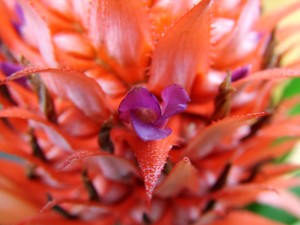In the Iguazú river and the delta islands grow several trees that need high humidity. They are different species at the site: the curupay, the cupay, laurel white and ingá aguay, as well as the kapok, whose flower has been declared National Flower Argentina.
 Due to the weather are some oddities, highlighting two communities considered special cupay forest composed of deciduous trees that sprout leaves are copper colored and lilloi Paspalum grassland, a grass that grows between the stones of the river. These species are only found in this region.
Due to the weather are some oddities, highlighting two communities considered special cupay forest composed of deciduous trees that sprout leaves are copper colored and lilloi Paspalum grassland, a grass that grows between the stones of the river. These species are only found in this region.
Orchids in Niagara
The tree flora Iguazu National Park has more than 90 species, such as black Lapacho, that at the end of winter and before its leaves completely covered pink flowers, the yellow and ibirá Lapacho pytá, with yellow flowers, and a kind ceibo jungle flowers with red-orange.
In some sections of this National Park a very special community develops: palmitoy jungle rosewood. The latter is a tree that can be over 40 meters tall and has straight trunk up to 2 meters in diameter. In its shade and other large trees, palmettos grow, graceful palms whose stems end in a heart edible, highly coveted, whose extraction causes the death of the plant.
Between the majestic tree species that can be seen, we find the guatambú white, black and cancharana laurel, whose trunks are lined by cascades of epiphytes and climbers. Among them, a graceful palm grows, of smaller size, the Pindo, with a slender trunk that can reach 20 m high, crowned by a tuft of long pinnate (feather shaped). They are joined aguay the yellow oleander and to a lesser amount, the petiribí coveted for its high value timber. Beyond the tops of these trees, often emerge true giants of more than 30 m high, like incense, the Ybirá pitá, the ambay, tail molle and timbó or pacará spectacular, impressive for its height and thickness of its trunk.
A special case is that of guapoy, or fig ibapoí bravo, whose seeds are left by birds and mammals that feed on figs, cavities or crevices in trees. There germinate, thanks to the organic matter from decaying bark, and roots are thin wrapping the tree to the ground to strengthen into a single trunk. Thus, the guapoy ends up killing the original tree, replacing it in the tree layer, to develop a large cup and reach a height of 20 m.
In the middle layer beckon tree ferns and fleshy fruit trees, below these levels, a multitude of ferns and shrubs including nettle does not go unnoticed brava, with large leaves that are in contact stinging.

















